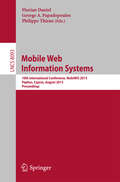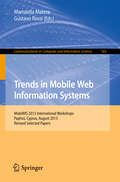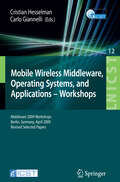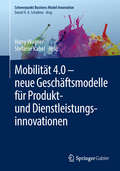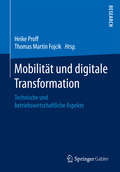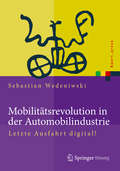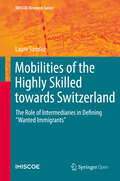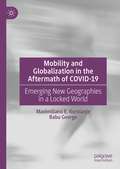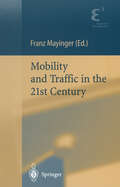- Table View
- List View
Mobile Web Information Systems: 10th International Conference, MobiWIS 2013, Paphos, Cyprus, August 26-29, 2013, Proceedings (Lecture Notes in Computer Science #8093)
by Florian Daniel George A. Papadopoulos Philippe ThiranThis book constitutes the refereed proceedings of the 10 th International Conference on Mobile Web Information Systems, MobiWIS 2013, held in Paphos, Cyprus, in August 2013. The 25 papers (20 full research papers, 4 demonstration papers, and one abstract of the keynote speech) presented were carefully reviewed and selected from various submissions. The papers cover the following topics related to mobile Web and Information Systems (WISs), such as mobile Web services, location-awareness, design and development, social computing and society, development infrastructures and services, SOA and trust, UI migration and human factors, and Web of Things and networks.
Mobile Web Information Systems: MobiWIS 2013, International Workshops, Paphos, Cyprus, August 26-28, Revised Selected Papers (Communications in Computer and Information Science #183)
by Maristella Matera Gustavo RossiThis book constitutes the revised selected papers of the workshops of the 10th International Conference on Mobile Web Information, MobiWIS 2013, held in Paphos, Cyprus, in August 2013. The conference hosted two workshops: the First International Workshop on Future Internet of Things and Cloud, FICloud 2013, focusing on the Internet of Things and its relation with cloud computing and the Fourth International Workshop on Service Discovery and Composition in Ubiquitous and Pervasive Environments, SUPE 2013, addressing the issues that characterize automatic service composition in ubiquitous and pervasive computing. The 14 papers presented were carefully reviewed and selected from various submissions.
Mobile Wireless Middleware, Operating Systems and Applications - Workshops: Mobilware 2009 Workshops, Berlin, Germany, April 28-29, 2009, Revised Selected Papers (Lecture Notes of the Institute for Computer Sciences, Social Informatics and Telecommunications Engineering #12)
by Cristian HesselmanSoftware systems for wireless and mobile communications are a key component in pervasive computing and are crucial for the materialization of easy-to-use and intel- gent services that people can use ubiquitously. As indicated by its acronym (MOBILe Wireless MiddleWARE, Operating Systems, and Applications), these are the type of systems that form the topic of the MOBILWARE conferencing series. In particular, the goal of MOBILWARE is to provide a forum for researchers and practitioners to disseminate and discuss recent advances in software systems for wireless and mobile communications, ranging from work on communication middleware and operating systems to networking protocols and applications. For its second edition, held in Berlin in April 2009, the MOBILWARE Organizing Committee decided to add a full day of workshops on topics related to the main c- ference. Our goals were threefold: 1. Put together a high-quality workshop program consisting of a few focused wo- shops that would provide ample time for discussion, thus enabling presenters to quickly advance their work and workshop attendees to quickly get an idea of - going work in selected research areas. 2. Provide a more complete picture of ongoing work by not only including technical workshops, but also workshops on business and user aspects. We expected that this multi-viewpoint approach would be an added value as technology, business m- els, and user experiences are usually interrelated. 3. Create a breeding ground for submissions for MOBILWARE 2010 and beyond.
Mobiler Journalismus (Journalistische Praxis)
by Björn StaschenDer Band bietet eine Einführung in die Möglichkeiten des "mobile Journalism" und wirft einen Blick auf das journalistische Handwerk 2.0. Es zeigt, welche Technik erforderlich ist und welche Erfahrungen Journalisten gesammelt haben. Es gibt Tipps und erläutert Tricks für die tägliche Arbeit.
Mobilising Capital for Emerging Markets: What Can Structured Finance Contribute?
by Doris KöhnIs structured finance dead? Many have asked this question after the financial crisis. Or is structured finance “evil” and therefore should it be dead? This book suggests neither nor. Even if structured finance can be misused or applied under inappropriate conditions, it can also be an effective tool for reaching development objectives. The authors in this volume focus on the potential of structured finance in the aftermath of the financial crisis. They explore the conditions under which structured finance is suitable for emerging markets highlighting both its benefits and risks. The book combines professional and scientific perspectives and points towards various useful applications of structured finance in support of small and medium-sized enterprises and microfinance. This also includes activities as diverse as infrastructure development, remittances, rural livelihood, and Shari’ah-compliant Islamic finance.
Mobilising The Power Of What You Know
by Paul MillerOn any given day, in the most large and medium-sized organisations, there are many indviduals and teams at work on the same issues, trying to solve problems from scratch that someone else in the company has already solved. What a waste! and what an opportunity! Knowledge management - or, as author Paul Miller prefers to call it, knowledge mobilisation - is currently being billed as a critical tool for the 21st century corporation. It concerns maximising the capabilities of the people working in a company by capturing their knowledge and turning it into a corporate asset. As Charles Handy has noted, no executive would leave factory space or cash idle, but many confess that they use only a small fraction of the knowledge latent in their companies. This book shows in a thoroughly practical way how to mobilise that knowledge and expertise and set it to work. It is plentifully illustrated with case studies of named UK companies who have done this successfully including NCR, ABB Asea Brown Boveri, 3I Group, Mortgage Express and Burston Marsteller.
Mobilität 4.0 – neue Geschäftsmodelle für Produkt- und Dienstleistungsinnovationen (Schwerpunkt Business Model Innovation)
by Harry Wagner Stefanie KabelDieses Buch verdeutlicht, mit welchen innovativen Geschäftsmodellen die Mobilitätsbedürfnisse der Zukunft befriedigt werden könnten. Die Autoren stellen praxisnah und wissenschaftlich fundiert Ansätze, Instrumente und Konzepte im Kontext der Mobilität 4.0 vor. Neben einer Einführung für die Entstehung neuer Geschäftsmodelle im Bereich Mobilität befassen sich die Kapitel mit einem Flatrate-Car der Zukunft und verschiedenen App-Anwendungen zur Optimierung intermodaler Verkehrsketten. Zudem werden Aspekte und Lösungen vorgestellt, wie Mobilität für körperlich Bedürftige verbessert werden kann. Anhand von Fallbeispielen werden konkrete Mobilitätskonzepte erläutert.
Mobilität aus Kundensicht: Wie Kunden ihren Mobilitätsbedarf decken und über das Mobilitätsangebot denken
by Sven Henkel Torsten Tomczak Stefanie Henkel Christian HaunerDie Autoren entwickeln ein Insight-Mobility-Konzept, in dem vier Entscheidungsalternativen aus kundenrelevanter Sicht unterschieden werden: „Ich fahre“, „Ich werde gefahren“, „Ich lasse fahren“, „Ich verweile“. Die Autoren stellen Marktforschungsdaten zu den bedeutendsten Mobilitätsangeboten zusammen und ergänzen diese um Erkenntnisse aus Tiefeninterviews, die mit 24 Mobilitätsnutzern und -experten geführt wurden. Auf dieser Basis werden acht Mobilitätstypen und deren individuelle Mobilitätsprofile identifiziert.
Mobilität in Zeiten der Veränderung: Technische und betriebswirtschaftliche Aspekte
by Heike ProffDer Tagungsband zum 10. Wissenschaftsforum Mobilität an der Universität Duisburg-Essen im Juni 2018 untersucht das Rahmenthema „Mobility in Times of Change: Past – Present –Future“ und fokussiert den Übergang von der alten (Auto-)Mobilität in eine neue Mobilität. Die Autorinnen und Autoren geben nicht nur einen Rückblick auf die Themen des Mobilitätsforums in den vergangenen 10 Jahren, sondern wagen einen Ausblick auf die kommenden 10 Jahre. In den Plenumsvorträgen, Präsentationen und Posterbeiträgen wird somit der Bogen von der Mobilität Ende des 19 Jahrhunderts bis in die Zukunft geschlagen.
Mobilität nach COVID-19: Grenzen – Möglichkeiten – Chancen
by Wolfgang H. Schulz Nicole Joisten Christina F. EdyeFliegen, Autofahren und auf engem Raum mit Fremden U-Bahn und Busse teilen – das war bisher der Mobilitätsalltag vieler Menschen. Doch innerhalb weniger Wochen ist unsere Welt durch COVID-19 beinahe zum Stillstand gekommen. Die Pandemie offenbart systembedingte Schwächen der deutschen Verkehrspolitik und der Aktivitäten großer mobilitätsrelevanter Unternehmen. Die Veränderungen sind in sämtlichen Mobilitätssektoren zu spüren. In diesem Buch kommen Experten aus verschiedenen Bereichen zusammen, um die Entwicklungen zu analysieren, Probleme zu erörtern, aber auch Opportunitäten zu finden. Wie kann die Mobilitätsbranche trotz der Krise nach vorne blicken? Könnte sie sogar profitieren? Das Innovationspotenzial und die Chancen für Veränderungen und Innovationen sollten jetzt wahrgenommen werden, um eine agilere Basis für den Mobilitätsmarkt zu schaffen.
Mobilität und digitale Transformation: Technische und betriebswirtschaftliche Aspekte
by Heike Proff Thomas Martin FojcikDer Tagungsband zum 9. Wissenschaftsforum Mobilität an der Universität Duisburg-Essen im Juni 2017 untersucht den Einfluss der fortschreitenden Digitalisierung auf traditionelle Automobilunternehmen und neue Mobilitätsanbieter. Die Beiträge des Forums an den Schnittstellen der betriebswirtschaftlichen und ingenieurwissenschaftlichen Forschung geben dazu einen umfassenden Einblick und zeigen Möglichkeiten auf, wie Unternehmen die digitale Transformation erfolgreich bewältigen können.
Mobilität und Karriere: Eine Fallstudie am Beispiel einer deutschen Großbank (Bank- und Finanzwirtschaft)
by Constance PauluConstance Paulu analysiert das Mobilitäts- und Karriereverhalten und -handeln von Führungs- und Nachwuchsführungskräften anhand einer qualitativen und quantitativen empirischen Untersuchung bei der Deutsche Bank AG.
Mobilität von Studierenden im Übergang ins Berufsleben: Die Änderung mobilitäts-relevanter Einstellungen und der Verkehrsmittelnutzung (Studien zur Mobilitäts- und Verkehrsforschung)
by Annika Busch-GeertsemaAnnika Busch-Geertsema untersucht, inwiefern sich Mobilitätsverhalten und mobilitätsbezogene Einstellungen im Zuge eines Lebensereignisses ändern. Auf einer zwischen Psychologie und Geographie angesiedelten theoretischen Grundlage sowie mittels einer dreistufigen Panelbefragung von Studierenden, die im Befragungszeitraum ins Berufsleben eingetreten sind, werden mithilfe bi- und multivariater Analysemethoden Erkenntnisse zur (In)Stabilität der Verkehrsmittelnutzung und der Einstellungen herausgearbeitet. Weiterhin identifiziert die Autorin potentielle Faktoren, die im Zusammenhang mit dem Übergang ins Berufsleben stehen.
Mobilitäts- und Transportrecht in Europa: Bestandsaufnahme und Zukunftsperspektiven (Bibliothek des Wirtschaftsrechts #2)
by Simon Laimer Christoph PerathonerDieser Open Access Band beleuchtet den weit über die wissenschaftliche Community hinaus diskutierten Bereich der Personen- und Gütermobilität aus einer Vielzahl unterschiedlicher Perspektiven. Das Buch zeichnet sich durch seinen interdisziplinären Ansatz aus: neben rechtlichen Rahmenbedingungen werden auch Aspekte aus Verkehrswirtschaft, Technik sowie nachhaltiger Verkehrspolitik beleuchtet, unter anderem anhand von Großprojekten wie dem österreichisch-italienischen Brennerbasistunnel und der Neuen Eisenbahn-Alpentransversale in der Schweiz. Zunächst werden die Instrumente zur Verwirklichung des europäischen Binnenmarkts im Transport- und Verkehrsrecht behandelt. Darauf werden Fragen der internationalen gerichtlichen Zuständigkeit und des anwendbaren Vertragsrechts bei der grenzüberschreitenden multimodalen Güterbeförderung in der EU auf der Grundlage aktueller Judikatur diskutiert. Im Bereich des internationalen Warenhandels werden Querbezüge zwischen UN-Kaufrecht und COTIF-Eisenbahngüterbeförderungsrecht (CIM) hergestellt. Ferner werden die aktuell vieldiskutierten haftungsrechtlichen Herausforderungen des automatisierten Fahrens sowie die umstrittene Frage der Luftreinhaltung durch Verkehrsverbote in den Städten behandelt. Darauf folgt die Diskussion kartellrechtlicher Fragen von Kooperationen im grenzüberschreitenden Eisenbahnverkehr. Den Ausgangspunkt für dieses Buch bildete eine Tagung an der Universität Innsbruck.
Mobilitätsrevolution in der Automobilindustrie: Letzte Ausfahrt digital! (Xpert.press)
by Sebastian WedeniwskiInternet der Dinge, Cloud Computing, vernetztes Fahrzeug, Big Data, Analytics – was hat all dies eigentlich mit der Automobilindustrie zu tun? Dieses Buch gibt Auskunft über die Zukunft der Mobilität: die Trends, die sich aus Digitalisierung, Vernetzung, Individualisierung und Datenfokussierung ergeben. Der Automobilindustrie steht eine grundlegende Transformation bevor. Vor allem die großen, traditionellen Unternehmen werden sich umstellen müssen, neue Geschäftsmodelle entwickeln und diese flexibel umsetzen, mit Hilfe entsprechender Unternehmensarchitekturen. Der Schlüsselbegriff dabei: Geschäftskompetenzen. Die digitale Zukunft des Fahrzeugs hat bereits begonnen – wer wird sie mitgestalten?
Mobilitätsverhalten im Stadtverkehr: Eine empirische Untersuchung zur Akzeptanz verkehrspolitischer Maßnahmen (DUV Wirtschaftswissenschaft)
by Ralf SchellhaseRalf Schellhase diskutiert die Bedeutung und die Wirkung von Verkehr und stellt Maßnahmen zu seiner Beeinflussung sowie die Ziele und Motive der am verkehrspolitischen Entscheidungsprozess beteiligten Interessengruppen vor.
Mobilitätsverhalten von Unternehmen: Eine industrieökonomische Analyse (neue betriebswirtschaftliche forschung (nbf) #115)
by Thorsten PosseltMarkteintritt und Marktaustritt sind die wichtigsten Bestimmungs gründe für die Existenz von Wettbewerbsmärkten. Die neoklassische Theorie fordert, daß im Gleichgewicht kein potentieller Eindringling den Eintritt und keine bestehende Firma den Austritt profitabel findet. Betrachten die Unternehmen die Marktpreise als gegeben -und das tun sie ja im Spielplan des neoklassischen Marktgleichgewichts -, so bedeutet das für den Eintritt: Ein potentieller Eindringling bleibt draußen, wenn der Preis nicht höher als die minimalen Durchschnitts kosten ist. Und für den Austritt: Eine bereits auf dem Markt agierende Firma, ein potentieller Austreter also, bleibt, wenn der Preis nicht unter den minimalen Durchschnittskosten liegt. Folglich ist der Preis im Gleichgewicht gleich den minimalen Durchschnittskosten. Das bekannte Ergebnis der Gleichgewichtstheorie, diesmal hergeleitet von den Bedingungen für Ein- und Austritt, also von den Bedingungen potentieller Konkurrenz. Wieder einmal hatte die neoklassische Gleichgewichtstheorie alles geregelt (diesmal potentieller Ein- und Austritt, potentielle Konkurrenz), allerdings auch hier auf der Ebene von Gleichgewichts bedingungen, empirisch nicht faßbar und ohne Folgen für wettbe werbspolitisches Handeln. Nun ist die neoklassische (Selbst)sicherheit bereits früh herausgefordert worden durch die Oligopoltheorie. Man braucht nicht bis zum frühen Vorläufer Cournot (1828) zurückzugehen, selbst wenn man die Robinson-Chamberlin-Kontroverse der dreißiger Jahre nimmt, bleibt es erstaunlich, daß das Konzept des potentiellen Wettbewerbs in der Oligopol- und der Monopoltheorie erst in den fünfziger Jahren systematisch behandelt wird.
Mobilities of the Highly Skilled towards Switzerland: The Role of Intermediaries in Defining “Wanted Immigrants” (IMISCOE Research Series)
by Laure SandozThis open access book analyses the strategies of migration intermediaries from the public and private sectors in Switzerland to select, attract, and retain highly skilled migrants who represent value to them. It reveals how state and economic actors define “wanted immigrants” and provide them with privileged access to the Swiss territory and labour market. The analysis draws on an ethnographic study conducted in the French-speaking Lake Geneva area and the German-speaking northwestern region of Switzerland between 2014 and 2018. It shows how institutional actors influence which resources are available to different groups of newcomers by defining and dividing migrants according to constructed social categories that correlate with specific status and privileges. This research thus shifts the focus from an approach that takes the category of highly skilled migrant for granted to one that regards context as crucial for structuring migrants’ characteristics, trajectories, and experiences. Beyond consideration of professional qualifications, the ways decision-makers perceive candidates and shape their resource environments are crucial for constructing them as skilled or unskilled, wanted or unwanted, welcome or unwelcome.
Mobility and Globalization in the Aftermath of COVID-19: Emerging New Geographies in a Locked World
by Maximiliano E. Korstanje Babu GeorgeThis book argues that COVID-19 revives a much deeper climate of terror which was instilled by terrorism and the War on Terror originally declared by Bush's administration in 2001. It discusses critically not only the consequences of COVID-19 on our daily lives but also “the end of hospitality”, at least as we know it.Since COVID-19 started spreading across the globe, it affected not only the tourism industry but also ground global trade to a halt. Governments adopted restrictive measures to stop the spread of the virus, including the closure of borders, and airspace, the introduction of strict lockdowns and social distancing, much of which led to large-scale cancellations of international and domestic flights. This book explores how global tourists, who were largely considered ambassadors of democratic and prosperous societies in the pre-pandemic days, have suddenly become undesired guests.
Mobility and Inequality Trends (Research on Economic Inequality #30)
by Sanghamitra Bandyopadhyay Juan Gabriel RodríguezResearch on Economic Inequality is a well-established publication of quality research. This 30th volume features insightful and original papers from the 9th Society for the Study of Economic Inequality (ECINEQ) meeting. Mobility and Inequality Trends begins by illustrating the trajectory of income inequality in the world over the course of recent decades before the second paper makes a crucial distinction between ‘bad’ inequality, which is detrimental to society, and ‘good’ inequality, which is beneficial. Focus then shifts to bad inequality, one paper covering the relationship between intergenerational elasticity and inequality of opportunity, and the second studying the relationship between intergenerational mobility and life satisfaction in Spain. The volume then progresses to defend the use of intermediate views of inequality when constructing indicators of social welfare obtained through the use of average income and the Gini coefficient before investigating the advantage of using a multifaceted approach to income mobility measurement. To conclude Mobility and Inequality Trends presents an intensive exploration of income inequality in China and then studies the effects of the policy measure “Minimum Living Income. Finally, the last paper studies the impact of the COVID-19 pandemic on economic stimulus policies.
Mobility and Inequality Trends (Research on Economic Inequality #30)
by Sanghamitra Bandyopadhyay and Juan Gabriel RodríguezResearch on Economic Inequality is a well-established publication of quality research. This 30th volume features insightful and original papers from the 9th Society for the Study of Economic Inequality (ECINEQ) meeting. Mobility and Inequality Trends begins by illustrating the trajectory of income inequality in the world over the course of recent decades before the second paper makes a crucial distinction between ‘bad’ inequality, which is detrimental to society, and ‘good’ inequality, which is beneficial. Focus then shifts to bad inequality, one paper covering the relationship between intergenerational elasticity and inequality of opportunity, and the second studying the relationship between intergenerational mobility and life satisfaction in Spain. The volume then progresses to defend the use of intermediate views of inequality when constructing indicators of social welfare obtained through the use of average income and the Gini coefficient before investigating the advantage of using a multifaceted approach to income mobility measurement. To conclude Mobility and Inequality Trends presents an intensive exploration of income inequality in China and then studies the effects of the policy measure “Minimum Living Income. Finally, the last paper studies the impact of the COVID-19 pandemic on economic stimulus policies.
Mobility and Traffic in the 21st Century
by Franz MayingerMobility is a prime need of mankind. It is the basis not only of economical and technical but also of cultural progress. Many questions arise with respect to the development and the problems of mobility in the 21st century. This book presents the results elaborated by a project team consisting of students of the "Bayrische Elite-Akademie". They applied themselves to four main topics: - Bimodal transport system. - Mobility and transport in agglomoration areas. - Analogies of physical and virtual traffic. - How communication technologies influence the future of mobility. The book is of interest to both the industrial and the acadamic community and can also be used by students. It is directed at the group of people interested in future traffic policy in general and in traffic engineering in particular.
Mobility-as-a-Service: The Convergence of Automotive and Mobility Industries (Management for Professionals)
by Malte AckermannThe advent of mobility-as-a-service and the disruption of the automotive industry are both overlapping and fuelled by the same developments and thus raise a very fundamental question: are we at peak car? Based on the author’s extensive field research, academic study, and professional experience, this book explores this very question as well as the underlying social, economic, generational, and regulatory changes that lead to a new mobility regime. Through rich descriptions of established OEMs and mobility start-ups, it discusses the current forms of mobility and the promise of autonomous technology. It further explores the strategic dimension of these developments so as to navigate and succeed within the disruptive and ever-changing environment of mobility services.
Mobility between Africa, Asia and Latin America: Economic Networks and Cultural Interactions (Politics and Development in Contemporary Africa)
by Ute Röschenthaler Alessandro JedlowskiTrade connections and cultural exchange between Africa and the rest of the global South have existed for centuries. Since the end of the Cold War, these connections have expanded and diversified dramatically, with emerging economies such as China, India, and Brazil becoming increasingly important both as sources of trade and as a destination for African migrants. But while these trends have attracted growing scholarly attention, there has so far been little appreciation of the sheer breadth and variety of this exchange, or of its deeper social impact.This collection brings together a wide array of scholarly perspectives to explore the movement of people, commodities, and ideas between Africa and the wider global South, with rich empirical case studies ranging from Senegalese migrants in Argentina to Lebanese traders in Nigeria. The contributors argue that this exchange represents a form of 'globalization from below' which defies many of the prevailing Western assumptions about migration and development, and which can only be understood if we consider the full range and complexity of migrant experiences.Multidisciplinary in scope, Mobility between Africa, Asia and Latin America is essential reading for students and scholars across the social sciences interested in the interconnected economic and social make-up of the global South.
Mobility between Africa, Asia and Latin America: Economic Networks and Cultural Interactions (Politics and Development in Contemporary Africa)
by Ute Röschenthaler and Alessandro JedlowskiTrade connections and cultural exchange between Africa and the rest of the global South have existed for centuries. Since the end of the Cold War, these connections have expanded and diversified dramatically, with emerging economies such as China, India, and Brazil becoming increasingly important both as sources of trade and as a destination for African migrants. But while these trends have attracted growing scholarly attention, there has so far been little appreciation of the sheer breadth and variety of this exchange, or of its deeper social impact.This collection brings together a wide array of scholarly perspectives to explore the movement of people, commodities, and ideas between Africa and the wider global South, with rich empirical case studies ranging from Senegalese migrants in Argentina to Lebanese traders in Nigeria. The contributors argue that this exchange represents a form of 'globalization from below' which defies many of the prevailing Western assumptions about migration and development, and which can only be understood if we consider the full range and complexity of migrant experiences.Multidisciplinary in scope, Mobility between Africa, Asia and Latin America is essential reading for students and scholars across the social sciences interested in the interconnected economic and social make-up of the global South.
